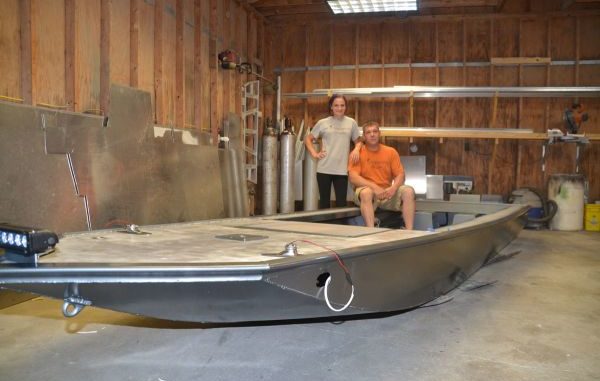
Corey and Samantha “Sam” Crochet founded Cottonmouth Custom Boats (225-456-0930) in February 2013. And frogging is an activity that dovetails well with their young boat business.
They work at the shop during the daylight hours seven days a week, and then they chase frogs during the night.
Their first frogging trips together were to test the performance and design of their boats. Now they frog because they like to frog.
Corey Crochet calls the annual two-month closed season during April and May “a killer,” because they don’t have an excuse to get on the water.
While Corey has always frogged, Sam is a newcomer to the sport.
“At first,” the 5-foot, 4-inch, purple-haired dynamo giggled, “I didn’t want to touch them. I was kind of girly. Now I absolutely love it.”
Husband Corey was quick to jump to her aid.
“She’s missed very few frogs since the first trip,” he bragged.
Both Crochets have good outdoors credentials.
Samantha Hotard grew up saltwater fishing in the Grand Isle-Leeville area, spending a week or two at a time at her Aunt Cindy’s and Uncle Robert Maranto’s camp.
“I’ve gotten Corey hooked on saltwater fishing,” Sam said, something to which her husband readily admits. “I’ve fished in redfish tournaments for three years now.”
“I didn’t get involved in hunting until I met Corey. I got my first buck five years ago — a 5-pointer. We also hunt squirrels and rabbits in Back-Brusly.
Corey grew up in Brownfields, halfway between Baton Rouge and Baker.
His grandfather, Willie I. Williams, had a camp in Bayou Sorrell on the edge of the Spillway. His uncle, Glen Rushing, had a hunting lease at Ramah north of Bayou Sorrell. Corey spent his winters hunting in Ramah and the rest of the year at the fishing camp at Bayou Sorrell.
“My Grandpa gave me a 12-foot Eldocraft,” Corey explained. “My dad Erlin, who everybody called ‘Joey,’ gave me a 4-horse outboard, and they cut me loose. I fished and swung on a rope swing into the bayou. I spent a lot of time in Pat’s Bayou fishing for sac-a-lait and bass.
“Nowdays, I fish in Leeville for redfish and trout. Gosh, I love flounder. I still fish in the Spillway, and the Amite River (where he caught his world-record white bass) is my go-to spot. I wish I could fish every day.”
The couple of 11 years works side by side in the boat business.
“I do everything but weld,” Sam said. “I am the secretary and do the accounts, write price quotes, keep the website up and I work in the shop.”
“She’s out there all day — dirty and sweaty, with cuts and bruises,” Corey added fondly. “She’s my country girl.
“The boat business has changed our lives. I get to spend every day with Sam.”
One of the changes involved risk. Sam gave up her regular income and insurance when she left her job with the Central School Board to work with her husband.
Corey drew by hand the design for their first boat.
“I have a vivid imagination, and if I can imagine it, I can build it,” he said. “Most people who build boats have a fabrication shop background, not an on-the-water background.
After years of working on other people’s boats and in commercial fishing, I realized that most boats are not built practically. My main objective was to build a boat that was functional — usable. Everything on our boat has a reason — a purpose.”
Their bread-and-butter design is the XLR8 (pronounced “ex-cel-er-ate”) in 10- to 20-foot lengths with 44-, 48- or 56-inch bottom widths. Most common are 14- to 18-foot-long boats with 48-inch bottoms.
Square bows are standard, but they build boats with pointed bows, as well.
Each hull is built of a single piece of aluminum that has been shaped with one crimp and two bends. Corey believes that bent-chine (where the side of a boat meets the bottom) hulls have performance advantages over welded, square-chined hulls.
The couple also has another item in their line-up: the SD Trail Pro.
This device serves to transfer the weight of a surface drive engine, which can weigh 240 to 280 pounds, from the boat’s transom to the boat trailer, thereby protecting the transom from damage caused the yank and bounce of the motor as the boat is being trailered.
The device is universal and fits all surface drive motors.
With the pride of a father, Corey explained the Cottonmouth company name.
“The boat’s draft is so light it looks like it is floating on top of the water, like a cottonmouth snake does,” he said.
For the unknowing, a surefire way to separate a poisonous cottonmouth snake from a look-alike, nonpoisonous water snake in the water is that a cottonmouth swims mostly on top of the water, while a water snake swims with most of its body under the water’s surface.
Oh, and about Sam’s purple hair: She explained that all the while that she worked at the school board office she couldn’t do anything “off the wall.”
And she likes purple.